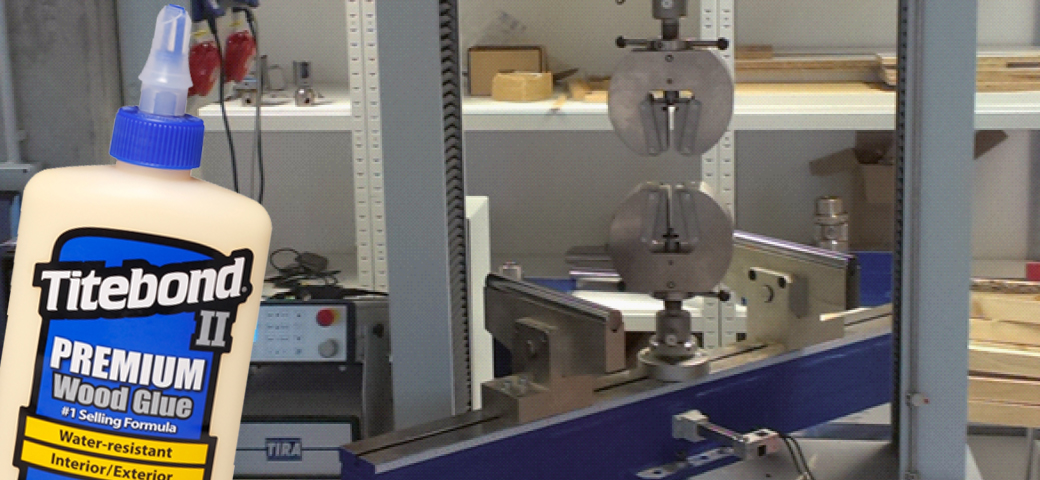
In today’s article, we will discuss the ideal bond pressure and the change of bond firmness due to heating or cooling. We have targeted the Titebond II Premium glue for testing. We left the professional part to Ing. Pavel Boška from the Czech University of Life Sciences in Prague, who tested the glue in his laboratory.
The Basis of Gluing
Glueing can be described as a link between two mutually adjacent materials in a solid state using a substance in a liquid or solid form in a liquid or plastic state. This substance has the ability to generate a solid and sufficient bond between the glued materials.
The general rule for a proper adhesive function is both high adhesion to the surface and cohesion, the strength of the glue itself.
The Importance and the Effect of the Compaction Pressure and Temperature on Bond Strength
Pressure
The pressure when bonding is ideal for the elimination of unevenness on the surface of the glued material and allows the glue to create a thin closed layer. The applied pressure must allow the bonded surfaces to be as close as possible, but avoid compression of wood. When applying too much pressure, the glue can be extruded out of the bond line and create a weak bond. A well-chosen pressure should enable an even distribution of the adhesive in the joint. The pressure should be equally high on the surface.
Temperature
The adhesive temperature is one of the most important factors during hardening. You don’t have to wait several hours to achieve a firm bond, in some cases, you can shorten this process dramatically to minutes or even seconds by heating the bonded joint. The higher the pressing temperature, the shorter the time for hardening of the adhesive.
Testing the minimum compacting pressure
A series of samples with different compacting pressure (0 – 2 Mpa) have been made to determine the minimum glueing pressure when using the Titebond II Premium glue (the data list indicates 0,7-1,7Mpa as ideal). We have deliberately ignored the recommended conditions of pressure specified in the datasheet. Our testing showed that using the 0-2 Mpa pressure does not produce any statistical difference in the resulting bond strength. In other words, if the glued pieces are pressured together with a minimal force so that they are in a sufficient contact, the bond still complies to the minimum requirement set by the strength standard of 10Mpa. In practice, this would mean that you won’t need any special pressure accessories and would simply get by with a couple of regular clamps.
If you comply with the recommended pressure between 0,7-1,7 MPa, the glued joint will be at its maximum strength.
Test effect of temperature on the strength of the glued joint
Titebond belongs among thermoplastic adhesives, which could be re-worked by heat even after hardening. The testing procedure was conducted as follows: we have heated a hardened joint into specific temperatures ranging 20-140 °C and observed at what point would the bond become weaker. The decline of bond strength was equal. A surprising finding was that even at 70 °C, Titebond II Premium held its bond strength standard of 10 Mpa, set by the EN 204 norm as a minimum standard in normal conditions. Thanks to this capability, the adhesive holds strong even when exposed to sunlight.
We have also found out, that the glue starts to melt in temperatures above 120 °C, therefore the bond can be dismantled without any damage to the wood. We have also tested the difference of firmness after heating the joint (40-140 °C) and letting it cool down to 20 °C. In this case, we have recorded, that the bond got even stronger after repeated cooling, it has increased from 16 Mpa when heated on 40 °C, to more than 17-19 Mpa on 60-80 °C, which other adhesives failed to do.
Even at temperatures ranging 100-140 °C, the firmness stayed the same after cooling, being approximately above 12Mpa.
The Conclusion of Ing. Pavel Boška from Czech University of Life Sciences in Prague:
"I believe that the results and findings will interest all joiners, who expect a firm glued bond, simple and comfortable use as well as ability to work in extreme conditions. Titebond II Premium offers unique capabilities when compared to other tested adhesives."